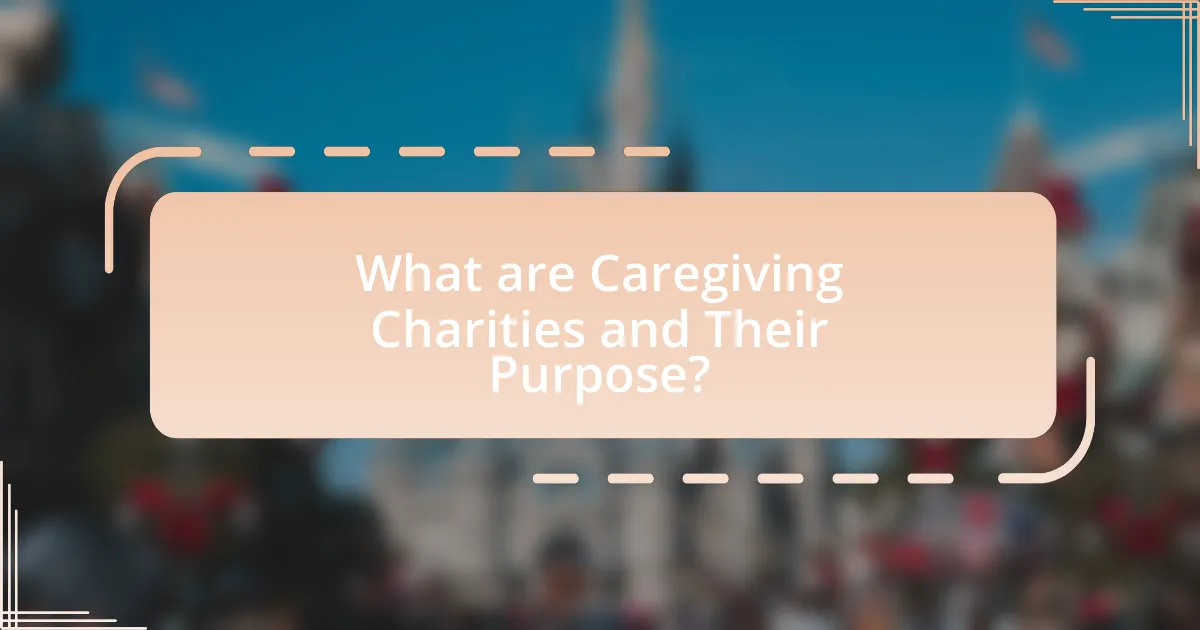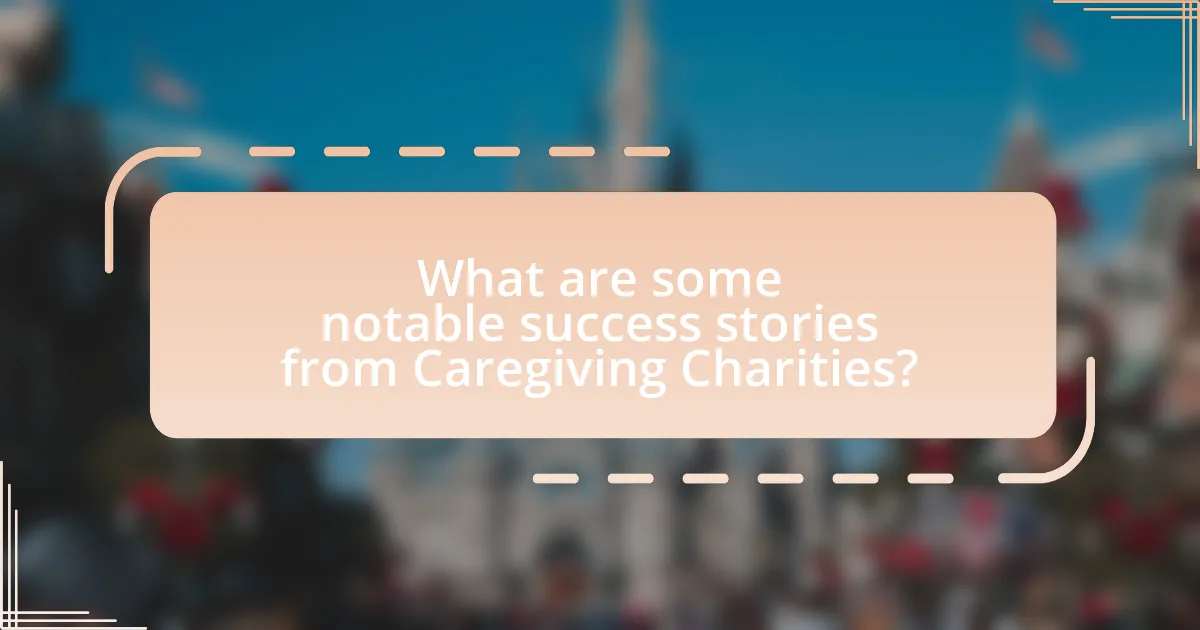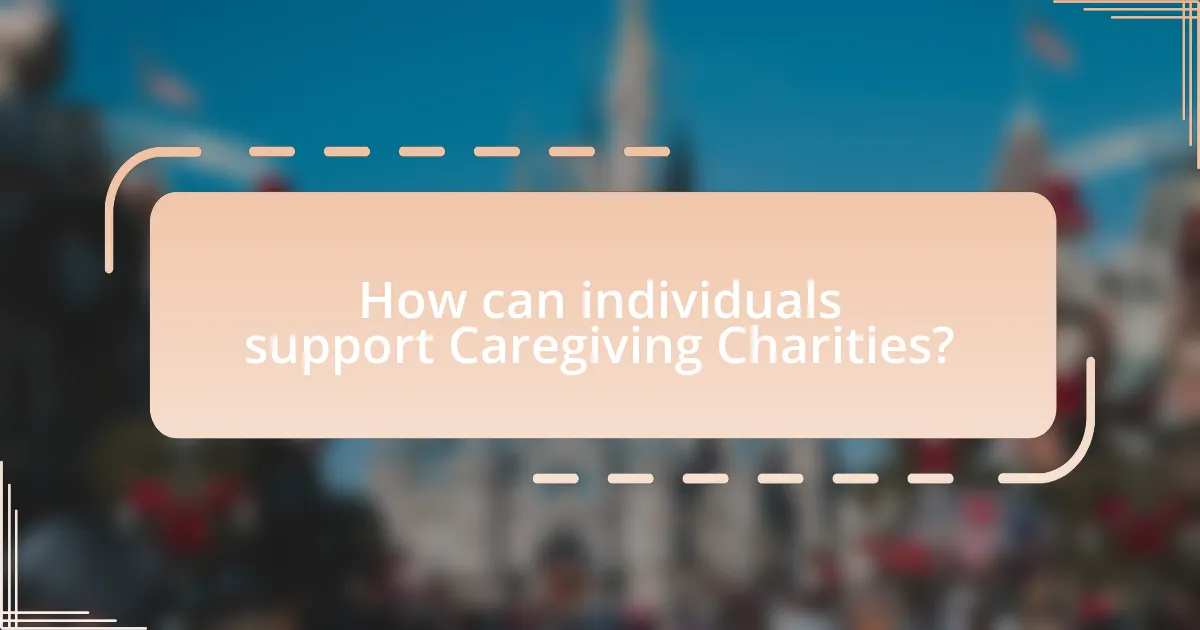Caregiving charities are organizations that provide vital support, resources, and assistance to caregivers and those they care for, addressing challenges such as emotional stress and financial burdens. The article explores the operations of these charities, the types of services they offer, and their funding mechanisms, highlighting their importance in society. It also discusses the significant impact these charities have on individuals and families, showcasing notable success stories and the transformative effects of their programs. Additionally, the article examines the challenges faced by caregiving charities and outlines effective strategies for individuals to support these organizations, emphasizing the role of community involvement in enhancing their outreach and effectiveness.

What are Caregiving Charities and Their Purpose?
Caregiving charities are organizations dedicated to providing support, resources, and assistance to caregivers and those they care for. Their purpose is to alleviate the challenges faced by caregivers, such as emotional stress, financial burdens, and lack of access to necessary services. For instance, according to the National Alliance for Caregiving, approximately 53 million adults in the U.S. are caregivers, highlighting the significant need for support systems. These charities often offer educational programs, respite care, and financial assistance, which can improve the quality of life for both caregivers and care recipients.
How do Caregiving Charities operate?
Caregiving charities operate by providing support, resources, and services to individuals in need of care, often focusing on vulnerable populations such as the elderly, disabled, or chronically ill. These organizations typically raise funds through donations, grants, and fundraising events, which they then allocate to various programs that offer direct assistance, such as respite care, counseling, and educational resources for caregivers. For example, the National Family Caregivers Association reports that caregiving charities have significantly improved the quality of life for caregivers and care recipients by offering essential services and support networks, thereby enhancing their overall well-being.
What types of services do Caregiving Charities provide?
Caregiving charities provide a range of services including respite care, financial assistance, emotional support, and educational resources for caregivers. Respite care allows caregivers to take breaks while ensuring their loved ones receive proper care, which is essential for preventing caregiver burnout. Financial assistance helps families cover medical expenses or caregiving costs, alleviating financial stress. Emotional support services, such as counseling and support groups, offer caregivers a space to share experiences and receive guidance. Educational resources equip caregivers with necessary skills and knowledge to improve care quality. These services collectively enhance the well-being of both caregivers and those they care for, demonstrating the significant impact of caregiving charities on individuals and families.
How do Caregiving Charities fund their operations?
Caregiving charities fund their operations primarily through donations, grants, and fundraising events. These organizations often rely on individual contributions, corporate sponsorships, and government grants to support their programs and services. For instance, according to the National Philanthropic Trust, charitable giving in the U.S. reached $471.44 billion in 2020, highlighting the significant role of donations in sustaining nonprofit activities. Additionally, many caregiving charities organize events such as charity runs, galas, and auctions, which not only raise funds but also increase community awareness and engagement.
Why are Caregiving Charities important in society?
Caregiving charities are important in society because they provide essential support and resources to individuals and families facing health challenges. These organizations help bridge the gap in care, offering services such as respite care, financial assistance, and emotional support, which are crucial for caregivers who often experience high levels of stress and burnout. For instance, according to the National Alliance for Caregiving, approximately 34 million Americans provide unpaid care to an adult age 50 or older, highlighting the significant role of caregiving in society. By alleviating some of the burdens faced by caregivers, these charities enhance the quality of life for both caregivers and those they care for, ultimately fostering a healthier community.
What impact do Caregiving Charities have on individuals and families?
Caregiving charities significantly enhance the well-being of individuals and families by providing essential support services, resources, and emotional assistance. These organizations often offer respite care, financial aid, and educational programs that alleviate the burdens faced by caregivers, allowing them to focus on their loved ones’ needs. For instance, a study by the National Alliance for Caregiving found that 61% of caregivers reported feeling less stressed after receiving support from caregiving charities, demonstrating the positive impact on mental health and family dynamics. Additionally, these charities facilitate community connections, fostering a sense of belonging and reducing isolation among caregivers, which further contributes to improved overall family resilience.
How do Caregiving Charities address gaps in healthcare and support?
Caregiving charities address gaps in healthcare and support by providing essential services that are often overlooked by traditional healthcare systems. These organizations offer resources such as respite care, emotional support, and financial assistance to caregivers, which helps alleviate the burden of caregiving responsibilities. For example, the National Alliance for Caregiving reports that nearly 34 million Americans have provided unpaid care to an adult age 50 or older, highlighting the significant need for support services. By filling these gaps, caregiving charities enhance the quality of life for both caregivers and those receiving care, ensuring that critical needs are met and promoting overall well-being.

What are some notable success stories from Caregiving Charities?
Notable success stories from caregiving charities include the work of the Alzheimer’s Association, which has significantly improved support for families affected by Alzheimer’s disease through its 24/7 helpline and educational programs. In 2020, the organization reported reaching over 1.5 million individuals with its resources, demonstrating a tangible impact on caregivers’ lives. Another example is the National Alliance for Caregiving, which has provided vital research and advocacy, leading to policy changes that benefit millions of caregivers across the United States. Their 2020 report highlighted that 53 million Americans are caregivers, underscoring the importance of their initiatives in enhancing caregiver support and recognition.
How have Caregiving Charities transformed lives?
Caregiving charities have transformed lives by providing essential support and resources to individuals and families facing health challenges. These organizations offer services such as financial assistance, respite care, and emotional support, which significantly alleviate the burdens of caregiving. For instance, a study by the National Alliance for Caregiving found that 61% of caregivers reported improved well-being after receiving assistance from caregiving charities, highlighting the positive impact on mental health and quality of life. Additionally, caregiving charities often facilitate community connections, fostering a sense of belonging and reducing isolation among caregivers, which further enhances their overall life satisfaction.
What specific examples illustrate the impact of Caregiving Charities?
Caregiving charities have significantly impacted individuals and families through various programs and initiatives. For instance, the Alzheimer’s Association provides support services that have helped over 1.5 million families cope with the challenges of dementia, offering resources like care consultations and support groups. Similarly, the National Alliance for Caregiving has conducted research that highlights how their programs improve caregiver well-being, showing that 70% of caregivers report feeling less stressed after participating in their support initiatives. These examples demonstrate the tangible benefits that caregiving charities provide, enhancing the quality of life for both caregivers and those they care for.
How do these success stories inspire others to contribute?
Success stories inspire others to contribute by demonstrating the tangible impact of charitable efforts on individuals and communities. When people witness the positive changes brought about by caregiving charities, such as improved quality of life for beneficiaries, they are motivated to participate and support similar initiatives. For instance, statistics show that 70% of individuals who learn about successful charitable projects are more likely to donate or volunteer, as they feel a personal connection to the outcomes achieved. This emotional resonance, combined with clear evidence of success, encourages a cycle of giving and involvement, amplifying the reach and effectiveness of caregiving charities.
What challenges do Caregiving Charities face in achieving success?
Caregiving charities face significant challenges in achieving success, primarily due to funding limitations, volunteer recruitment, and regulatory hurdles. Funding limitations restrict the resources available for programs and outreach, as many charities rely on donations and grants that can be inconsistent. For instance, a report from the National Council of Nonprofits indicates that 70% of nonprofits struggle with financial sustainability. Volunteer recruitment is another challenge, as caregiving roles often require time and commitment that potential volunteers may not be able to provide. Additionally, regulatory hurdles can complicate operations, as charities must navigate complex legal requirements that can vary by state and impact service delivery. These factors collectively hinder the ability of caregiving charities to effectively support those in need.
How do funding limitations affect the operations of Caregiving Charities?
Funding limitations significantly hinder the operations of caregiving charities by restricting their ability to provide essential services and support. These financial constraints often lead to reduced staffing, limiting the number of caregivers available to assist those in need, which directly impacts the quality and quantity of care provided. For instance, a study by the National Council of Nonprofits indicates that 75% of nonprofits report that funding challenges have forced them to cut programs or services. Consequently, caregiving charities may struggle to meet the growing demand for assistance, ultimately affecting the lives of vulnerable populations they aim to serve.
What strategies do Caregiving Charities use to overcome obstacles?
Caregiving charities employ various strategies to overcome obstacles, including community engagement, partnerships, and resource allocation. Community engagement allows these organizations to build strong relationships with local stakeholders, ensuring that they understand the specific needs of caregivers and those they support. Partnerships with healthcare providers and other nonprofits enhance their capacity to deliver services and share resources effectively. Additionally, strategic resource allocation enables caregiving charities to prioritize funding and support where it is most needed, maximizing their impact. For instance, the National Alliance for Caregiving collaborates with various organizations to provide comprehensive support, demonstrating the effectiveness of these strategies in addressing challenges faced by caregivers.

How can individuals support Caregiving Charities?
Individuals can support caregiving charities by making financial donations, volunteering their time, and raising awareness about the causes these organizations champion. Financial contributions provide essential resources for caregiving programs, while volunteering allows individuals to directly assist in caregiving activities, enhancing the support offered to those in need. Additionally, raising awareness through social media or community events can help attract more supporters and resources to these charities. According to the National Philanthropic Trust, charitable giving in the U.S. reached $471.44 billion in 2020, highlighting the significant impact that individual contributions can have on nonprofit organizations, including caregiving charities.
What are effective ways to contribute to Caregiving Charities?
Effective ways to contribute to caregiving charities include making financial donations, volunteering time, and organizing fundraising events. Financial donations provide essential resources for charities to support caregivers and those in need, with studies showing that even small contributions can significantly impact operations and outreach. Volunteering time allows individuals to directly assist in caregiving activities, enhancing the charity’s ability to serve its community. Organizing fundraising events can raise awareness and generate additional funds, as evidenced by successful campaigns that have raised thousands for caregiving initiatives.
How can volunteering make a difference in Caregiving Charities?
Volunteering can significantly enhance the impact of caregiving charities by providing essential support and resources that directly benefit those in need. Volunteers contribute their time and skills, which allows charities to expand their services, reach more individuals, and improve the quality of care provided. For instance, a study by the Corporation for National and Community Service found that volunteers in health-related organizations increased service capacity by 20%, enabling charities to assist more clients effectively. This increase in manpower not only alleviates the workload of paid staff but also fosters a sense of community and compassion, which is vital in caregiving environments.
What are the benefits of donating to Caregiving Charities?
Donating to caregiving charities provides essential support for individuals and families in need, enhancing their quality of life. These charities often fund critical services such as respite care, counseling, and financial assistance, which directly alleviate the burdens faced by caregivers. For instance, a study by the National Alliance for Caregiving found that 34% of caregivers reported financial strain, highlighting the importance of financial support from donations. Furthermore, contributions to these charities can lead to improved mental health outcomes for caregivers, as they receive necessary resources and respite, ultimately benefiting both caregivers and those they care for.
What best practices can enhance the impact of Caregiving Charities?
To enhance the impact of caregiving charities, implementing targeted community engagement strategies is essential. Engaging with local communities allows charities to identify specific needs and tailor their services accordingly, which increases relevance and effectiveness. For instance, a study by the National Council of Nonprofits found that organizations that actively involve community members in decision-making processes see a 30% increase in program participation and satisfaction. Additionally, leveraging partnerships with healthcare providers can improve resource accessibility, as evidenced by the collaboration between the Alzheimer’s Association and local hospitals, which resulted in a 25% increase in support services for caregivers. Finally, utilizing data-driven approaches to measure outcomes ensures that charities can adapt and improve their programs based on real-world effectiveness, leading to sustained impact over time.
How can Caregiving Charities improve their outreach and engagement?
Caregiving charities can improve their outreach and engagement by leveraging digital marketing strategies, such as social media campaigns and targeted email newsletters. These methods allow charities to reach a broader audience, as 79% of adults in the U.S. use social media, providing a platform for sharing success stories and engaging potential donors. Additionally, hosting community events and workshops can foster local connections, as studies show that in-person interactions significantly enhance donor loyalty and volunteer participation. By utilizing data analytics to track engagement metrics, charities can refine their strategies to better meet the needs of their audience, ensuring that their outreach efforts are both effective and impactful.
What role does community involvement play in the success of Caregiving Charities?
Community involvement is crucial for the success of caregiving charities as it enhances resource mobilization, volunteer engagement, and awareness. When local communities actively participate, they provide essential support through donations, volunteer hours, and advocacy, which directly impacts the operational capacity of these charities. For instance, a study by the National Council of Nonprofits indicates that organizations with strong community ties report 50% higher fundraising success compared to those with limited community engagement. This involvement not only increases financial resources but also fosters a sense of ownership and commitment among community members, leading to sustained support and improved service delivery.